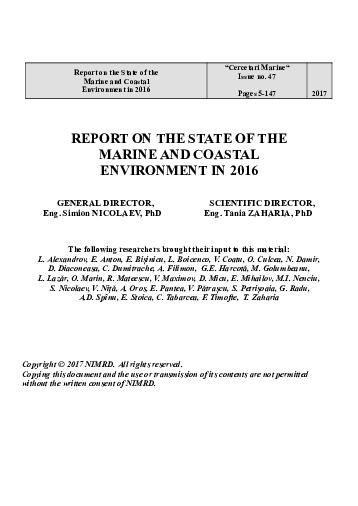Report on the State of the Marine and Coastal Environment in 2016
DOI:
https://doi.org/10.55268/CM.2017.47.5Keywords:
marine environment, eutrophication, contamination, biological components, marine living resourcesAbstract
This paper is an outline of the current state of the main components of the marineenvironment of the Black Sea in 2016. The data is part of the national Environmental State Report. The seawater temperature at Constanta, during the 12 months of the analyzed period was 1.49°C higher than the reference temperature (1959-2015). There is an increasing trend of 0.02°C/year throughout the period 1959-2016. Concerning the seawater transparency, the influence of the Danube in the northern part was strongly felt. The salinity ranged within the characteristic variability range of the Romanian coast, being influenced by the fresh water input. As far as eutrophication indicators are concerned, phosphate concentrations in coastal waters recorded in 2016 values close to those of the reference period of the 1960s, being only slightly higher. It was noted the risk of not achieving the target values for GES of Romanian Black. The comparison with GES target values highlighted the moderate risk of not achieving good status in coastal and northern marine water bodies. The results of the investigations carried out in 2016 on heavy metals in water, sediments and biota show differences in distribution between different sectors of the Romanian seashore, reflecting the potential impact of natural or anthropogenic pressures generated by coastal and offshore sources and activities. Total Petroleum Hydrocarbons (TPH) concentration indicated in 2016 a low level of pollution in seawater and a moderate level of pollution in sediments. In case of Polycyclic Aromatic Hydrocarbons (PAH), 78% of the values of individual compounds in water and 42% of total content the sediment exceeds the maximum admissible limit imposed by the current legislation, which shows a high level of pollution. Anthracene was the dominant compound in both water and sediment. In biota, concentrations of benzo[a]pyrene indicate a low level of pollution with PAHs. The biological components (phytoplankton, zooplankton, benthos) maintained the same tendency as in previous years. However, it must be noted that algal blooms had lower intensity and frequency compared to previous years. Concerning the marine living resources, in recent years the catches recorded an increasing trend, due to increasing Rapana venosa catches. In conclusion, the evolution of the monitored biotic parameters confirmed the restoration trend of the marine environment in recent years.
Downloads
Published
2017-12-02
How to Cite
Nicolaev, S., & Zaharia, T. (2017). Report on the State of the
Marine and Coastal
Environment in 2016. Cercetări Marine - Recherches Marines, 47(1), 5–147. https://doi.org/10.55268/CM.2017.47.5
Issue
Section
ORIGINAL ARTICLES
License
This is an open access journal, which means that all content is freely available without charge to the user or his/her institution. Users are allowed to read, download, copy, distribute, print, search, or link to the full texts of the articles, or use them for any other lawful purpose, without asking prior permission from the publisher or the author. This is in accordance with the BOAI definition of open access.






